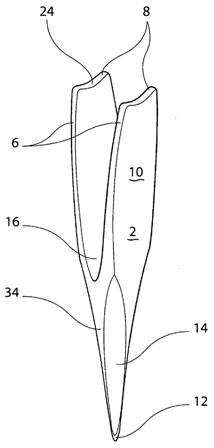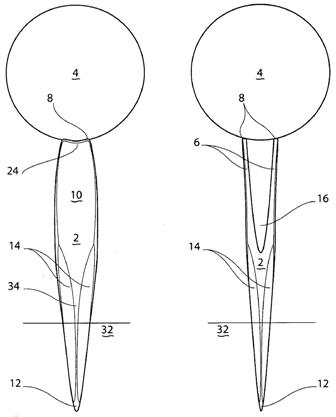Now This Is a Tee That I Would Buy (at least once)
An interesting golf tee patent application published this week as US Pub. No. 20100216576 titled “Golf Tee.” The application describes the invention as:
The application explains:
Pretty cool (at least as far as golf tees go).
Dave Dawsey - Monitoring Golf Tee Inventions
PS – check out other golf tee inventions HERE
A golf tee comprising parallel golf ball supporting fins extending from an elongated blade-like main body. The fins bend and flex with the rapid momentary expansion and compression of the golf ball due the impact from a golf club, thereby offering a clear and unimpeded exit channel for the golf ball. The elongated main body tapers to a point for easy insertion into the teeing ground and has large side surface areas for the clear display of logos and general indicia.
The application explains:
[0001] The sport of golf is well known and over many years has grown with international popularity. A sporting activity carried out by recreational enthusiasts to professional golfers alike; golf has been a physical and mental challenge since its debated creation in Scotland around 1456.
[0002] Golf has developed a huge industry shared by many companies and organizations, each keen on marking their presence, leadership and expertise in the sport. As such, the branding of equipment and the placement of general indicia, logos and messages throughout the game of golf has become commonplace.
[0003] Golf involves playing a ball with a club from the teeing ground into the hole by a stroke or successive strokes in accordance with the Rules.
[0004] A round of golf typically involves 9 to 18 holes each with an allocated teeing ground from which the golf ball is first struck over various terrains and obstacles towards a hole. It is standard practice amongst most golfers to use a golf tee to elevate the ball above the teeing ground to assist the golfer in striking the golf ball cleanly and efficiently with a golf club. A typical golf tee will be made from wood or resilient polymeric materials and consists of a cylindrical stem, tapering to a spike for insertion into the ground. On the other end is typically a circular head with a concave cup or dish surface to support the golf ball. Such tees are readily available and still in wide use.
[0005] However, golfers are very much aware of the performance issues surrounding all aspects of the game of golf, particularly where golf equipment is concerned. Over many years, there have been many improvements in the design and technology of golfing equipment in order to enhance the performance of the golfer. Improving the performance of a golf tee is no exception and golf tees are now receiving more focus and attention by the golf industry as a means to improve the golfer's first shot or "drive" from the teeing ground.
[0006] It can be demonstrated using high speed photography that when a golf ball is struck by a golf club, the golf ball will compress at the point of impact and rapidly expand outwards. This rapid distortion of the golf ball upon a standard rigid golf tee can contribute toward many unwanted dynamics and inefficiencies in the golf drive.
[0007] As such, issues relating to golf tee friction and golf ball resistance have been addressed in a variety of ways and solutions. Such solutions include tees with bristles or brushes to replace the traditional concave ball supporting dish. When the golf ball distorts, the bristles disperse allowing the ball to exit the tee with minimal friction and impedance. However, such tees are less durable and over time tend to become unusable. Additionally, such bristle or brush-tipped tees require several parts for manufacture, thereby increasing costs. As mentioned, the placement of logos and general indicia is also an important part of golf equipment. Such brush tees have no useful area upon which indicia can be placed and clearly displayed.
[0008] Other solutions include tees which claim to reduce the points of contact and coefficient of friction between the golf ball and the golf tee. However, such tees are often made from rigid materials and thereby do not accommodate or address the issue of rapid golf ball expansion during impact. Often being designed around the traditional narrow cylindrical golf tee, they again offer little or no useful surface area for adequate branding or indicia.
[0009] Accordingly, there exists a need for a golf tee that reduces contact with the golf ball and possesses a desirable level of flexibility and dispersion to accommodate the rapid expansion of the golf ball during impact. Furthermore, it would be desirable for such a tee to have adequate surfaces and areas onto which can be placed and displayed a variety of logos, messages and general indicia.
Pretty cool (at least as far as golf tees go).
Dave Dawsey - Monitoring Golf Tee Inventions
PS – check out other golf tee inventions HERE





Comments